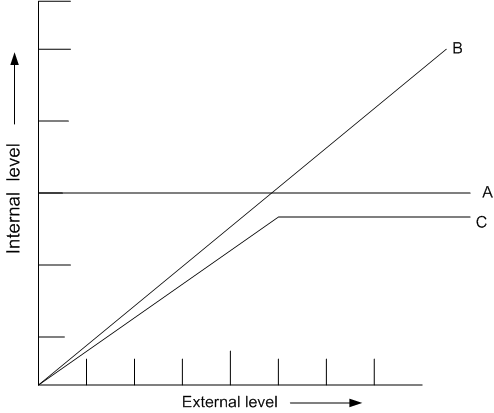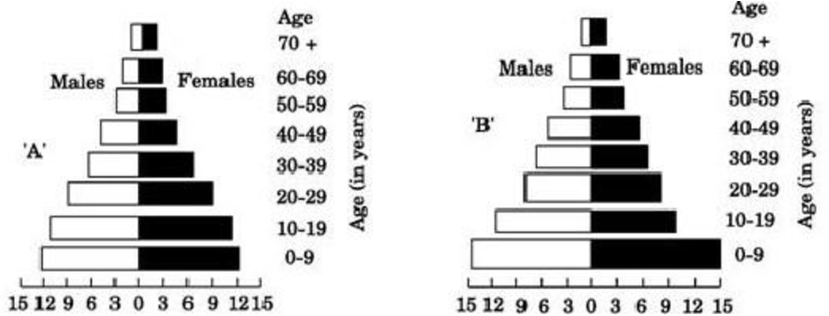 Multiple Choice Questions
Multiple Choice QuestionsConsider the following statements (I) - (IV) each with one or two blanks.
I. Bears go into ..... (1) .... during winter to .......(2) ..... cold weather.
II. A conical age pyramid with a broad base represents ......(3) ....... human population.
III. A wasp pollinating a fig flower is an example of ........ (4) ..........
IV. An area with high levels of species richness is known as ........ (5) .......
Which one of the following options give the correct fill up the respective blanks numbers from (1) to (5) in the statements.
(2) stable, (4) commensalism, (5) marsh
(1) aestivation, (5) escape, (3) stable, (4) mutualism
(3) expanding, (4) commensalism, (5) biodiversity park
(3) expanding, (4) commensalism, (5) biodiversity park
The figure given below is a diagrammatic representation of the response of organisms to abiotic factors. What do A, B, and C represent respectively?
|
A
|
B
|
C
|
|
Conformer |
Regulator |
Partial regulator |
|
A |
B |
C |
|
Regulator |
Partial regulator |
Conformer |
|
A
|
B
|
C
|
|
Partial regulator |
regulator | conformer |
|
A
|
B
|
C
|
|
Partial regulator |
regulator | conformer |
D.
|
A
|
B
|
C
|
|
Partial regulator |
regulator | conformer |
a) Regulator - mammals and birds
b) Conformer - all plants and 99% animals
c) Partial regulators -
Some hyperthermophilic organisms that grow in highly acidic (pH2) habitats belongs to the two groups called
eubacteria and archaea
cyanobacteria and diatoms
protists and mosses
protists and mosses
Which one of the following statemtents about morula in human is correct?
It has almost equal quantity of cytoplasm as an uncleaved zygote but much more DNA
It has far less cytoplasm as well as less DNA than in an uncleaved zygote
It has more or less equal quantity of cytoplasm and DNA as in uncleaved zygote
It has more or less equal quantity of cytoplasm and DNA as in uncleaved zygote
Which one of the following is most appropriately defined?
Host is an organism, which provides food to another organism
Amensalism is a relationship in which one species is benefited whereas the other is unaffected
Predator is an organism that catches and kills other organism for food
Predator is an organism that catches and kills other organism for food
A country with a high rate of population growth took measures to reduce it. The figure below shows age-sex pyramids of populations. A and B twenty years apart. Select the correct interpretation about them
Interpretations
'A' is more recent and shows slight reduction in the growth rate
'B' is earlier pyramid and shows stabilised
'B' is more recent showing that population is very young
'B' is more recent showing that population is very young
The table below gives the populations (in thousand) of ten species (A-J) in four areas (a-d) consisting of the number of habitats given within brackets aginst each. study the table and answer the question which follows:
|
Area and number of habitats
|
Species and their populations (in thousands) in the area |
|||||||||
|
A |
B |
C |
D |
E |
F |
G |
H |
I |
J |
|
|
a(11) b(11) c(13) d(12) |
23 |
1.2 |
0.52 |
6.0 |
- |
3.1 |
1.1 |
9.0 |
- |
10.3 |
|
10.2 |
- |
0.62 |
- |
1.5 |
3.0 |
- |
8.2 |
1.1 |
11.2 |
|
|
11.3 |
0.9 |
0.48 |
2.4 |
1.4 |
4.2 |
0.8 |
8.4 |
2.2 |
4.1 |
|
|
3.2 |
10.2 |
11.1 |
4.8 |
0.4 |
3.3 |
0.8 |
7.3 |
11.3 |
2.1 |
|
Which area out of a to d shows maximum species diversity?
b
c
d
d
What is true about the isolated small tribal populations?
There is a decline in population as boys marry girls only from their own tribe
Hereditary diseases like colour blindness do not spread in the isolated population
Wrestlers who develop strong body muscles in their lifetime pass this character on their progeny
Wrestlers who develop strong body muscles in their lifetime pass this character on their progeny
Consider the following statements concerning food chains
A) removal of 80% tigers from an area resulted in greatly increased growth of vegetation
B) removal of most of the carnivores resulted in an increased population of deers
C) length of food chains is generally limited to 3-4 trophic levels due to energy loss
D) the length of food chains may vary from 2 to 8 trophic level
Which two of the above statements are correct?
B and C
C and D
A and D
A and D
